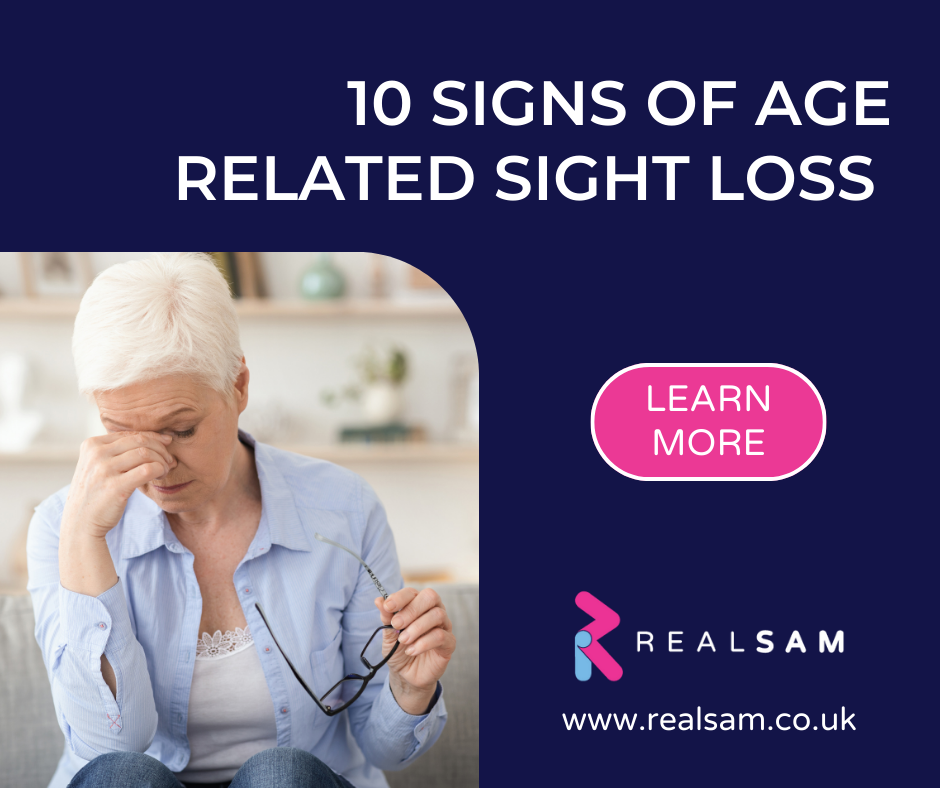Embracing retirement years comes with a unique set of adventures. But sometimes, our eyes need a little extra TLC to keep up with the journey. If you or a loved one notices changes in your vision, it’s time to pay attention to what your eyes may be going through. Here are 10 signs of age related sight loss. Knowing what to be aware of can empower you to be proactive about your health and eye care.
1. Changes in Visual Acuity
Have you found yourself squinting at the morning paper or holding the latest novel closer than usual? It’s not just your imagination playing tricks. These may be early signs of sight loss. It’s important to report changes to your doctor who could refer you to a full on eye check. Early attention could prevent further vision loss and other complications.
2. Increased Sensitivity to Light
Are bright lights causing you to squint? Do you find yourself reaching for a pair of sunglasses more often? Have you decreased the brightness of screens and devices? Maybe you can’t stand looking at websites with a lot of white space or bright colours. If you’re experiencing these things, your eyes have developed light sensitivity or photophobia. Light sensitivity and glares can be symptoms of different eye conditions like glaucoma. The sooner you can pinpoint the cause, the sooner you can work with your doctor towards a treatment or a solution.
3. Altered Colour Perception
The world is a vibrant canvas, but what if the colours start to blur? Have you noticed a subtle shift in the hues around you? Is it challenging to distinguish between certain colours? If you’re experiencing a general dimming of your colour perception, don’t ignore the changes. These could be indicative of various eye conditions such as cataracts or age-related macular degeneration. It’s a cue to check in with your doctor.
4. Difficulty Adjusting to Change
Is it becoming difficult to adjust from bright to dim environments and vice versa? It could be another sign that you’re experiencing sight loss. Your vision may become blurry or hazy. Or you see spots that take time to clear as you transition from one type of lighting to another. There may be a developing eye condition that needs to be addressed.
5. Impaired Night Vision
Is it harder to navigate at night? If you’re finding yourself squinting and struggling to decern shapes and shadows, don’t blame it on a long day. It’s another sign of of potential sight loss. If left unchecked, there’s greater risk for experiencing accidents, especially if you’re driving. It may also be disorienting to walk around. It’s vital to be aware of your sight at night. You want to avoid seemingly small trips and falls that are much harder for older individuals to recover from.
6. Frequent Prescription Adjustments
How many times have you had to change your prescription glasses in the past couple of years? While it’s great that you can get clearer vision with a new prescription, too many changes may be a sign that it’s time to consult with your doctor. There may be a an underlaying problem that hasn’t been detected. Or you may need to discuss a more lasting solution for better vision, like undergoing cataract removal surgery.
7. Reduced Peripheral Vision
Do you sometimes feel like you missed seeing something because you weren’t looking at it directly? This may be a sign that you’re experiencing reduced peripheral vision, or tunnel vision. Age related eye conditions like glaucoma, retinitis pigmentosa, and diabetes related retinopathy could cause tunnel vision. It’s vital that you get medical advice as soon as possible.
8. Eye Strain and Discomfort
Do you experience eye strain and discomfort? Maybe you feel tightness, pressure, and at times get headaches during or after visually demanding tasks like reading or working on the computer. Yes, it could just be inadequate lighting or focusing on something for too long, but it could also be a sign of vision issues. Be sure to check in with your doctor.
9. Random Mishaps
Have you felt frustrated due to random mishaps you can’t explain? Bumping into furniture or people, knocking over a glass, taking a long time to find an item that was right in front of you, not recognising someone, misreading a sign or a label, tripping, and missing steps… Don’t feel like you’re being careless or having a streak of bad luck. These occurrences may be because you’re experiencing changes to your vision.
10. Lights and Floaters
Do you sometimes see flashes of lights that aren’t really there? You may randomly see stars, sparks, and flashes of light. Additionally, eye floaters are spots in your vision that could look like small specks, larger shadows, or even strings. These may be caused by age-related changes in different parts of your eyes. It’s important to note and report your experiences with your doctor or eye care specialist.
Don’t Panic and Don’t Lose Sight
Remember, this journey is about discovery and empowerment. If you’re experiencing any of these signs, it may be sight loss or it may be altogether a completely different issue. Just be sure to consult with your doctor about issues and changes. This will help you make the most informed decision about your eye health. Sight loss or not, don’t lose sight—at this phase of life, you should be enjoying all the freedoms that come with your senior years. You’ve made it this far, don’t let any challenges stop you from being your best.
By Guenivir Kendrick


